If you have a bit of experience with aquariums and you’re looking to switch it up a bit, brackish water aquariums can a the perfect project!
In this guide, we dive into the basics of brackish fish tanks and a few of the species that we recommend keeping.
About Brackish Water Fish & Aquariums
In the context of this article (and most care guides), a brackish fish is a fish that thrives in a mixture of saltwater and freshwater.
It may be possible for some to live in both freshwater and saltwater, but they either will not thrive or will not survive in those conditions long.
When caring for a brackish fish, there are two pieces of equipment you need that are not necessary for freshwater fish.
You will need marine salt, which is different from aquarium salt, and a refractometer. Marine salt contains minerals and other materials that brackish and saltwater fish need.
A refractometer accurately measures the amount of salt in the water, which you will need for tank maintenance and water changes.
A hydrometer is commonly recommended, but these are often faulty and inaccurate, and a good refractometer only costs $10-15 more.
Aside from these two added components, brackish fish are just as easy to keep as freshwater fish.
While it is not recommended to jump into the aquarium hobby with a brackish tank, it is very possible for a beginner, who has had experience with freshwater fish, to transition to brackish fish quite easily.
14 of our Favorite Brackish Water Fish for Aquariums
Here are a few brackish water aquarium fish that you can keep at home:
1. Betta mahachaiensis
There is an ongoing debate on whether or not the commonly sold betta, Betta splendens, can survive small levels of salt in the water as temporary medication.
On the other hand, some of the wild betta species, primarily Betta mahachaiensis, thrive in brackish water.
This wild species of betta requires water with a low pH, between 5-7, heavy tannins, and hard water. While it is possible to keep them in freshwater, the water must be extremely hard.
If you cannot supply hard water, they also thrive in brackish water, and many recommend moderately hard water with some salt content instead of purely hard freshwater.
These fish are much more intriguing than the normal Betta splendens, though they do not have as much variety in coloration.
They are surprisingly easy to keep, in terms of a wild betta.
It is possible that they may require live food when you get them, but from experience, it normally only takes one to two weeks to switch them to prepared food.
One thing to be aware of is that they jump; high.
Any space in the lid, even a small opening for cords, needs to be covered with cling wrap or similar, because they will find their way out of the tank. Aside from this, they are a fun and hardy fish to keep.
2. Archer Fish
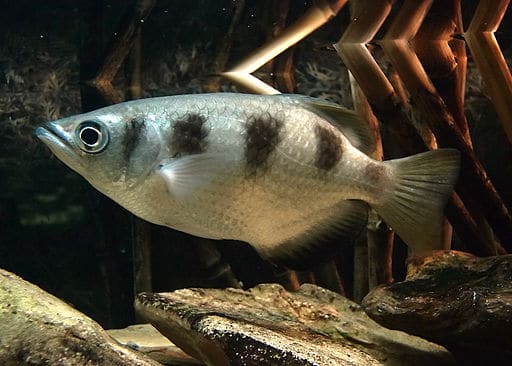
This is an extremely underrated and unique fish that is perfect for most any paludarium or large aquarium that needs something special.
They are best kept by experienced aquarists, as they need to be kept in groups, require over 100 gallons as a minimum tank size, and are finicky eaters.
The archer fish is aptly named for the way in which they hunt. This fish will either rapidly jump out of the water to grab prey, normally insects, or shoot a stream of water at the prey, forcing it into the water.
Their ability to shoot down their food earned them their name.
However, this means that they will look for food outside of the water, not pellets next to them. It is often necessary to supply live insect food while attempting to train them to eat prepared food.
While a young group of archer fish can be temporarily kept in freshwater, the adults must have brackish water in order to live.
In addition, you should lower the water level below the rim of the tank and have a very secure lid, similar to the bettas previously mentioned.
3. Figure 8 Puffer
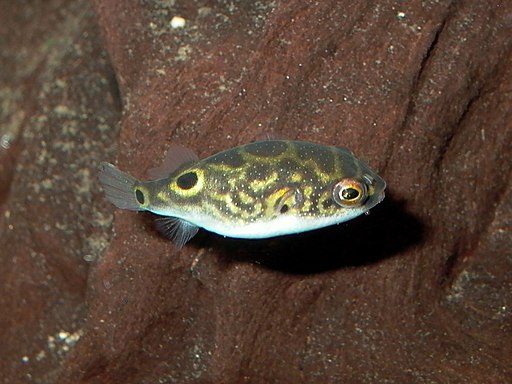
While there is debate over whether or not this fish should live in freshwater, brackish, or even full saltwater, most owners report them doing best in brackish water with salinity between 1.005-1.008.
Pufferfish are easy to get hooked on, and the figure 8 is a great one to own.
They are incredibly intelligent, which is a bonus as they can recognize and respond to their owners, but they can also become bored and depressed.
They can live in tanks as small as 15 gallons, though it is best to get a larger tank with more decorations to keep them entertained.
In addition, they can even be placed in a community tank with proper precautions. Their overall care is simple, but their feeding can be difficult and expensive.
At first, they may require live food, normally crickets, crayfish, shrimp, clams, and other such creatures, but they can be trained to accept high quality frozen food.
4. Green Spot Puffer
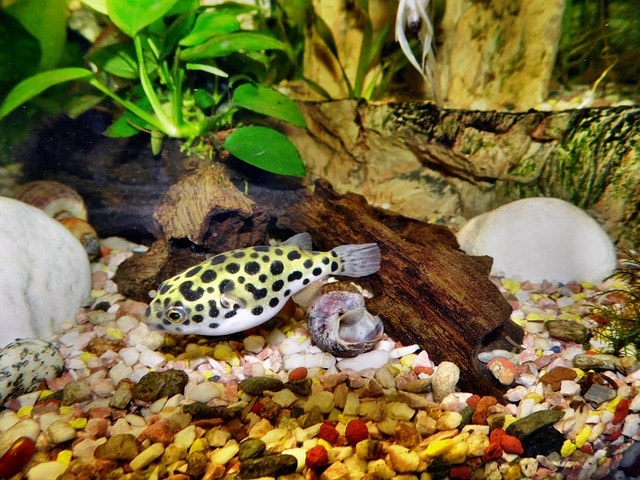
This pufferfish is more of what one would consider a typical pufferfish; with the opposite temperament of the previous one.
They are highly aggressive and cannot be kept with other fish, though some have had luck keeping two green spots together in tanks 60 gallons and larger.
While this fish only grows to 5-6 inches, a tank of 40 gallons or larger is best for them. They are highly personable and active, so even with just one fish in the tank, it will seem full.
The green spot pufferfish is also quite beautiful; they have a striking yellow back with black spots, which creates beautiful contrast.
Their diet is similar to the previous pufferfish, requiring high quality frozen food, primarily mollusks and shellfish.
This helps keep them healthy and keeps their “beaks” from growing too long.
In addition, as these pufferfish grow, you will have to continuously increase the salinity of their environment. Most young do well at 1.004-1.006 in terms of salinity, but an adult will need 1.02 or higher to thrive.
5. Dragon Goby
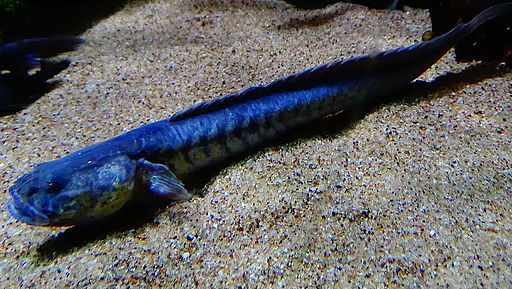
Dragon gobies have a very unique look; a large, frog like-head, small eyes, ever present sharp teeth, and a long spiny body resembling a bichir.
Let’s just say that no one chooses this fish for its beauty.
They are not particularly aggressive, but they will eat smaller fish and invertebrates.
It is possible for them to be housed in a community tank, but they may have trouble finding enough food due to their small eyes and poor vision.
The dragon goby frequently grows over a foot in captivity, so they need to be provided with ample room. A 60-gallon tank is the bare minimum for them.
They like to burrow in their substrate and hide, so a sand substrate coupled with a few large decorations, or even plants, would be ideal. They prefer salinity to be between 1.005 and 1.008.
6. Mollies

The common molly fish can be kept in freshwater, brackish water, and full marine salinity levels. This, coupled with their calm nature, makes them a versatile candidate for most community tanks.
While it is best to raise them in the type of water they were born in, it is possible to transition them to almost any water type, though this may take quite a while.
They can be kept alongside several of the aforementioned fish, including the figure 8 pufferfish and the dragon goby.
One of the things that makes mollies so popular is their diverse range of colors; no matter what color the tank, you will find a molly to match!
They are also peaceful, hardy, and easy to feed, so they make perfect starter fish for anyone beginning their journey into brackish aquariums.
7. Reed Fish
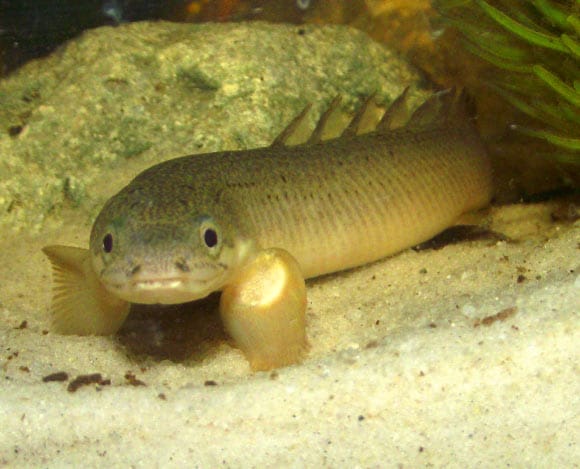
Reed fish, also called rope fish, behave and look more like eels than other typical aquarium fish. While they look reminiscent of the difficult-to-care-for bichir, their care is simple and straightforward.
Their requirements are actually similar to that of goldfish, and some even keep the two species together!
They need very large tanks, as they can reach over a foot in length, just like goldfish, with a 60 gallon being the absolute minimum. Reed fish do well in groups and need sand substrate with many hiding places.
They can tolerate salinity up to 1.020.
While they can be kept peacefully with other large fish, they are carnivorous. If you attempt to keep them with smaller fish like neon tetras, the tetras will “magically disappear”.
That being said, they do have a very peaceful nature, which is rare to see in eel-like fish.
8. Waspfish
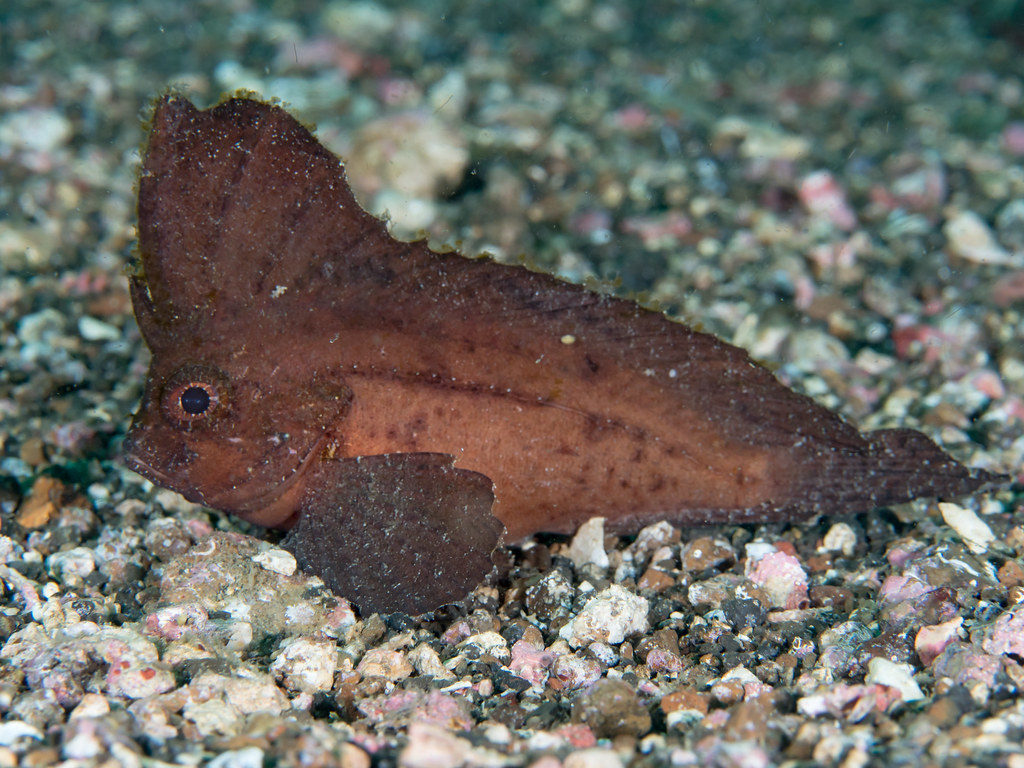
The waspfish, also called the leaf goblinfish, almost resembles a white and brown striated rock. But at least their big eyes make them a cute little rock.
This species lives in brackish and marine environments but is not capable of surviving in freshwater.
They are pickier about their care, and similar to the pufferfish, they may need live food, then high quality frozen food.
Lucky for you, they do not need high quality shrimp and clams, but simple frozen Mysis shrimp, bug larvae, bloodworms, and other normal fish food.
They are very small fish, and while they only grow to be 1-2 inches, a tank of at least 10 gallons, with larger being strongly recommended, is necessary to keep them alive.
They need many hiding areas to feel secure, and since they are sensitive to nitrogen compounds, you will need to test ammonia, nitrite, and nitrate more frequently.
9. Indian Mudskipper
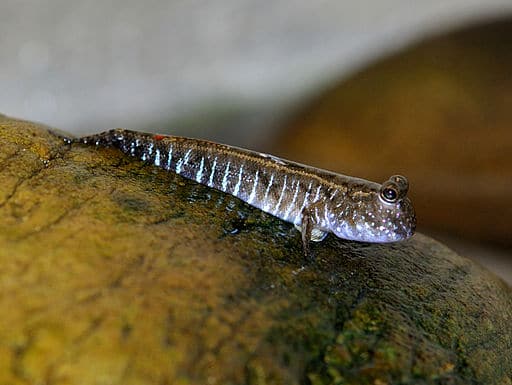
This list has many fish that are unique in one aspect or another, but the Indian Mudskipper may just take the cake.
Naturally occurring in brackish areas dominated by tides, they spend several hours of their day out of the water.
Unlike the other fish, the mudskipper cannot live in a normal aquarium.
They require part of the aquarium to be terrestrial, normally sand or silty mud, and the atmosphere in the paludarium must be very humid. Partially submerged wood can also accomplish this, and you can decorate it with plants.
They are best kept as a trio in a species only tank but may do well with other peaceful brackish fish. Each mudskipper needs about a square foot for territory, so long and wide tanks will do better than tall ones.
They do best on a diet of live food, though a mix of frozen and live is acceptable. This species is prone to bloat and obesity, and flake and pellet food often swells in their bellies and cause adverse side effects.
The necessity for frequent live food makes them tricky to care for but being able to keep a mudskipper is extremely rewarding.
10. Green Scat
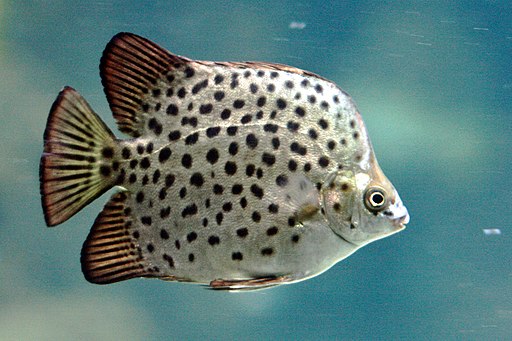
The green scat is a large spade shaped fish with iridescent gold, gray, and green coloration, interspersed with large black spots.
They are a favorite among those with brackish tanks due to their hardiness, peaceful nature, and gorgeous looks.
They are one of the easiest fish to keep on this list and will eat most pellet and flake food. Green Scats require a tank of at least 125 gallons, though larger is better. They can grow up to eight inches and require a school of at least six.
A specific gravity of 1.005 is best for these fish and finding similarly peaceful tank mates should not be an issue.
They will not do well with aggressive tank mates but will peacefully coexist with any fish large enough to avoid fitting into their mouths.
11. Tire Track Eels
The tire track eel is aptly named for the zig zagging tire track stripes across their bodies. They are one of the most popular eel species, as they can exist well in a community tank.
Tire track eels are not picky eaters, though this can be bad news for some of the fish in your tank.
While they are commonly sold between three and eight inches, they typically grow over two feet in the average aquarium, and roughly three feet in the wild.
They are semi aggressive, so if they are not provided with enough room, they may attack other fish.
An aquarium of at least 125 gallons is required to keep this beautiful species, as is sand substrate, as they spend much of their time burrowing.
Mild brackish water, around 1.005, is best for this species.
12. Columbian Shark Catfish
This is another beautifully iridescent fish, shimmering and flickering in any lighting.
At first, they look like miniature sharks that just happen to have barbs, but as they grow, they look closer and closer to the real thing.
While they are a peaceful species, they are carnivorous, so they will be snacking on smaller fish and invertebrates.
They reach up to and over ten inches in size and are best kept in an aquarium of at least 125 gallons.
They are easy to feed and relatively hardy, but their size is a challenge for newer fish keepers. For intermediate keepers, this is another fish that would be great to start exploring brackish aquariums with.
The young need less salinity, around 1.002, than the adults, who need their specific gravity around 1.005-1.010.
13. African Moony
These fish have a striking shape and pattern; they have a triangular silver body with long dorsal and ventral fins, giving them the appearance of a tall, irregular diamond.
Their iridescent silver bodies are laced with large black stripes, and they may also show yellow on the tips of their fins and the tops of their heads.
They do best when kept in small groups of six or more and should be kept in an aquarium of 125 gallons, as they will grow to be about a foot.
These catfish thrive in planted tanks that have wide open areas, as they like to quickly dart around.
While they are wild caught, most transition to typical fish food quickly, though they should also be fed some frozen food and blanched vegetables.
However, they may be difficult to feed at first, so be cautious and have some live food as a backup.
The African moony needs to have their salinity increased as they grow. Young ones can begin in freshwater, though 1.008 is ideal.
As they begin to grow, you need to continuously increase their salinity until they are adults, at which point their water’s specific gravity should sit at 1.025.
14. Golden Topminnow
The golden topminnow is a US native killifish that you may even be able to find in your backyard!
They have their typical golden variant, but there is also a melanistic variant that, while rare, is still naturally occurring in most populations.
They have a gorgeous, shimmering golden body speckled with highly reflective gold, orange, and even red scales.
The melanistic version has most of the same body type, but part of the body is either a smoky gray or covered in black speckles, which resembles a small trout.
The golden topminnow can be kept in a tank as small as ten gallons, as long as it is a heavily planted tank with slow water flow. They are peaceful, but also prone to being bullied by other fish.
This killifish is best kept in a harem style tank, meaning one male and multiple females.
While it is possible to keep them in a community tank, they are only 2” and extremely skittish, so the presence of other fish may force them to hide constantly.
They are incredibly hardy and can even be kept by a beginner. These golden fish are not picky eaters and will eat almost anything, so feeding them is rarely a difficulty.

